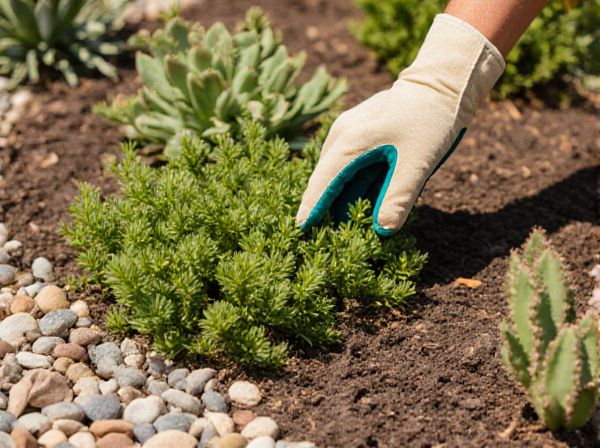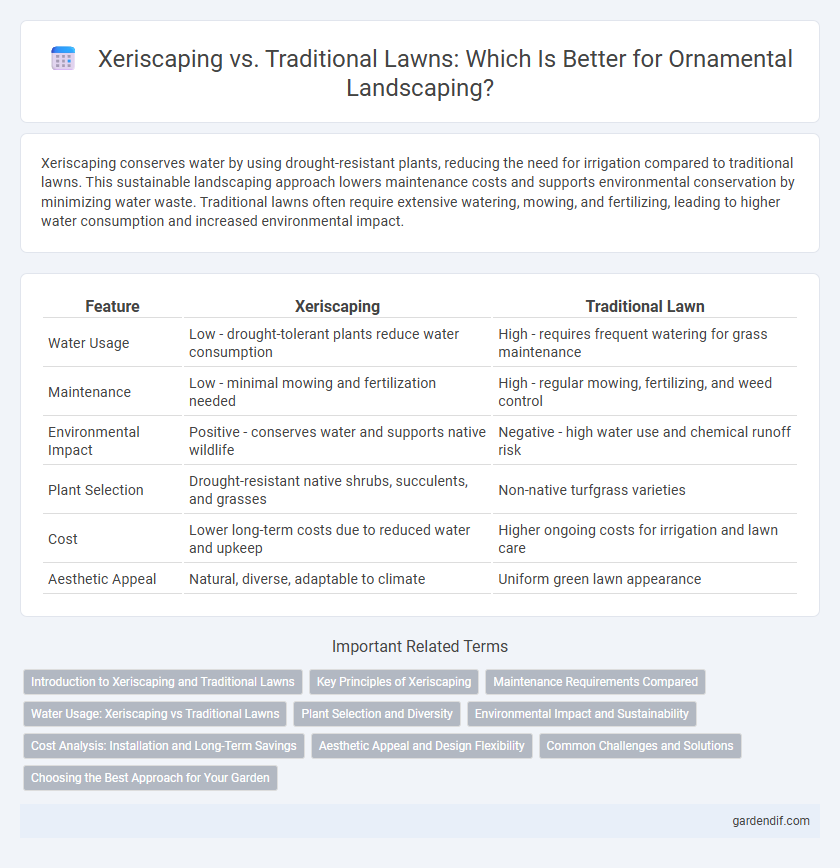
xeriscaping vs traditional lawn Illustration
Xeriscaping conserves water by using drought-resistant plants, reducing the need for irrigation compared to traditional lawns. This sustainable landscaping approach lowers maintenance costs and supports environmental conservation by minimizing water waste. Traditional lawns often require extensive watering, mowing, and fertilizing, leading to higher water consumption and increased environmental impact.
Table of Comparison
| Feature | Xeriscaping | Traditional Lawn |
|---|---|---|
| Water Usage | Low - drought-tolerant plants reduce water consumption | High - requires frequent watering for grass maintenance |
| Maintenance | Low - minimal mowing and fertilization needed | High - regular mowing, fertilizing, and weed control |
| Environmental Impact | Positive - conserves water and supports native wildlife | Negative - high water use and chemical runoff risk |
| Plant Selection | Drought-resistant native shrubs, succulents, and grasses | Non-native turfgrass varieties |
| Cost | Lower long-term costs due to reduced water and upkeep | Higher ongoing costs for irrigation and lawn care |
| Aesthetic Appeal | Natural, diverse, adaptable to climate | Uniform green lawn appearance |
Introduction to Xeriscaping and Traditional Lawns
Xeriscaping is a water-efficient landscaping method that utilizes drought-tolerant plants and minimal irrigation to conserve water while maintaining aesthetic appeal. Traditional lawns rely heavily on regular watering, fertilizing, and mowing, often resulting in higher water consumption and maintenance costs. Choosing xeriscaping promotes sustainability in ornamental gardening by reducing resource use, especially in arid climates, unlike conventional turfgrass systems.
Key Principles of Xeriscaping
Xeriscaping emphasizes water-efficient landscaping through principles such as soil improvement, strategic plant selection, and efficient irrigation techniques that contrast sharply with water-dependent traditional lawns. This method prioritizes drought-tolerant native plants and mulching to conserve moisture, reducing the need for frequent watering and maintenance. The approach integrates proper planning and sustainable practices to create attractive, eco-friendly ornamental spaces that thrive with minimal environmental impact.
Maintenance Requirements Compared
Xeriscaping significantly reduces maintenance requirements compared to traditional lawns by minimizing water usage, eliminating the need for frequent mowing, and decreasing fertilizer and pesticide application. Plants used in xeriscaping are drought-tolerant and adapted to local conditions, which enhances sustainability and reduces labor investment. In contrast, traditional lawns demand regular irrigation, mowing, and chemical treatments to maintain appearance and health, leading to higher costs and environmental impact.
Water Usage: Xeriscaping vs Traditional Lawns
Xeriscaping significantly reduces water usage compared to traditional lawns by incorporating drought-tolerant plants and efficient irrigation techniques, which can cut water consumption by up to 50-75%. Traditional lawns demand frequent watering to maintain their lush green appearance, often leading to excess water waste and higher utility bills. Implementing xeriscaping not only conserves water resources but also promotes sustainable landscaping practices in arid and semi-arid regions.
Plant Selection and Diversity
Xeriscaping emphasizes drought-tolerant plants such as succulents, native grasses, and desert shrubs, promoting biodiversity suited to arid climates while reducing water usage. Traditional lawns predominantly feature uniform grass species, which often require significant irrigation and maintenance. Selecting diverse, region-appropriate plants in xeriscaping enhances ecological resilience and supports local wildlife compared to the monoculture of traditional lawns.
Environmental Impact and Sustainability
Xeriscaping significantly reduces water consumption by using drought-tolerant plants, minimizing irrigation needs and conserving valuable freshwater resources. Traditional lawns require substantial water, fertilizers, and pesticides, contributing to higher carbon emissions and chemical runoff that harms ecosystems. Implementing xeriscaping enhances biodiversity, promotes soil health, and lowers maintenance energy, making it a more sustainable and environmentally responsible landscaping choice.
Cost Analysis: Installation and Long-Term Savings
Xeriscaping reduces installation costs by minimizing water infrastructure and using drought-tolerant plants, leading to significant savings compared to traditional lawns that require extensive irrigation systems. Long-term maintenance expenses for xeriscaped landscapes are lower due to reduced water bills, decreased fertilizer use, and less frequent mowing. In contrast, traditional lawns incur higher costs from ongoing watering, fertilizing, and lawn care services, increasing the total expense over time.
Aesthetic Appeal and Design Flexibility
Xeriscaping offers a modern aesthetic appeal characterized by diverse textures, colors, and drought-tolerant plants that create visually striking landscapes with minimal water use. Traditional lawns provide a uniform, lush green carpet that is synonymous with classic beauty and symmetry, appealing to conventional design preferences. Xeriscaping allows greater design flexibility by incorporating native plants, rocks, and mulch to form dynamic patterns, whereas traditional lawns often limit creativity to grass maintenance and linear borders.
Common Challenges and Solutions
Xeriscaping addresses common challenges of traditional lawns such as high water consumption, soil erosion, and maintenance costs by utilizing drought-tolerant plants and efficient irrigation systems. Traditional lawns often struggle with nutrient runoff and patchy growth due to overwatering and frequent mowing. Implementing mulch and native plant species in xeriscaping reduces water usage by up to 50%, improves soil health, and minimizes labor-intensive upkeep.
Choosing the Best Approach for Your Garden
Xeriscaping minimizes water use by incorporating drought-resistant plants and mulches, making it ideal for arid regions and sustainable gardening. Traditional lawns require regular irrigation, mowing, and fertilizing, which increases maintenance and environmental impact. Selecting the best approach depends on local climate, water availability, and desired garden aesthetics.
xeriscaping vs traditional lawn Infographic

 gardendif.com
gardendif.com